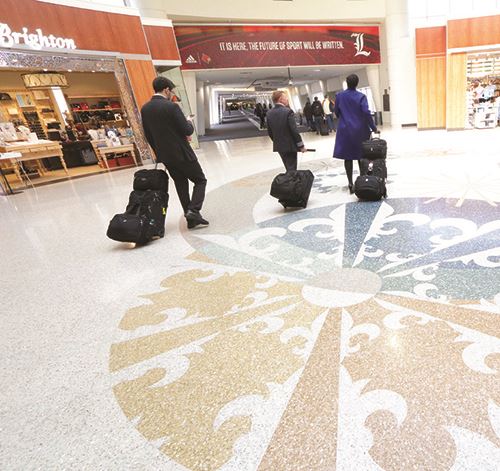A $21.7 million geothermal heating and cooling system currently being installed at Louisville Muhammad Ali International Airport (SDF) is the first of its magnitude at a U.S. airport. The project is designed to reduce the Kentucky airport’s energy costs for natural gas and electricity by roughly $400,000 annually. It also should reduce SDF’s carbon footprint by about 80%.
A $21.7 million geothermal heating and cooling system currently being installed at Louisville Muhammad Ali International Airport (SDF) is the first of its magnitude at a U.S. airport.
 The project is designed to reduce the Kentucky airport’s energy costs for natural gas and electricity by roughly $400,000 annually. It also should reduce SDF’s carbon footprint by about 80%, says Dan Mann, executive director of the Louisville Regional Airport Authority, which owns and operates SDF and nearby Bowman Field.
The project is designed to reduce the Kentucky airport’s energy costs for natural gas and electricity by roughly $400,000 annually. It also should reduce SDF’s carbon footprint by about 80%, says Dan Mann, executive director of the Louisville Regional Airport Authority, which owns and operates SDF and nearby Bowman Field.
The project began in September 2021 and is slated for completion in 2024. Funding includes a $10.6 million Voluntary Airport Low-Emission (VALE) grant from the FAA, with the balance paid by airport operating revenue.
|
Project: Geothermal Heating/Cooling System Location: Louisville (KY) Muhammad Ali Int’l Airport 2021 Passengers: 3.2 million Project Cost: $21.7 million Funding: $10.6 million VALE grant; airport operating revenue Construction: Late 2021-2024 System Components: 648 wells (500 ft. deep); 709,000 ft. of HDPE pipe; 85 heat pumps; automated monitoring system Design/Engineering Consultant: CMTA Prime Contractor: E&B Paving Drilling Contractor: Chesapeake Drilling Corp. Anticipated Benefits: $400,000 decrease in annual energy costs; 40% reduction in energy usage; 80% decrease in carbon footprint; paved well field creates additional room for aircraft parking; reduced HVAC maintenance costs; 2-3 times longer system lifecycle compared to conventional HVAC systems; better control over terminal air quality & comfort; capacity to support future terminal expansion |
“We expect the project will pay for itself in approximately 10 years, through reduced energy costs and decreased maintenance costs during the life of the system,” says Mann. “We also considered solar power, but geothermal had the biggest payback of anything we considered. It really got my attention when we heard it could save us $400,000 on utility bills.”
The heart of the system is 648 wells drilled 500 feet deep into a nine-acre parcel adjacent to the airport’s commercial carrier ramp. Heating and cooling requirements for the terminal dictated how many wells were needed and how deep they were drilled. Consulting firm CMTA provided design and engineering services for the project.
The new system will go online in phases as construction progresses during the airport’s $400 million terminal remodel, branded as SDF Next. “Everything is driven by the terminal work,” Mann notes. “The scheduling is very complex.”
More Parking Space
Beyond energy savings, the geothermal system will provide room for additional aircraft parking and possibly a deicing pad because most of the well field will be paved with concrete.
“We knew that piece of property would be a good place for drilling the wells because it could be paved, plus we don’t plan to build any structures in that area,” explains Brian Sinnwell, senior vice president and chief operating officer for the Louisville Regional Airport Authority.
Extra space for parking aircraft will come in especially handy during Kentucky Derby week each May, when flights into SDF jump dramatically. In addition, UPS planes could use the paved surfaces during the peak holiday shipping period from Thanksgiving through New Year’s Day. (SDF is the primary domestic hub for UPS Airlines and home to the delivery giant’s 5.2 million-square-foot Worldport package-processing facility.)
“You’re usually constrained with how you can use airfield space and there’s usually not a lot of it,” Mann notes. “So this is win-win-win situation on many fronts—financially, environmentally and operationally.”
In local parlance, that’s like winning the Triple Crown.
Innovative Solution
The terminal remodeling project opened the door for airport authority officials to consider an alternative to SDF’s current heating and cooling system, which relies on boilers and cooling towers.
“The terminal and its infrastructure is aging, including escalators, jet bridges and mechanical systems,” Mann explains. “They’re all getting old and reaching the end of their useful life.
“So we decided that if we have to replace the HVAC system, we should do something that would reduce our carbon footprint, decrease energy costs and last longer than conventional systems. Geothermal systems usually last two to three times longer than conventional HVAC systems.”
 Sinnwell notes that much of the strategizing occurred when the pandemic slowed down SDF’s master plan study, terminal remodeling and sustainability management study.
Sinnwell notes that much of the strategizing occurred when the pandemic slowed down SDF’s master plan study, terminal remodeling and sustainability management study.
“We took that time to reassess…and ask questions about what is possible, and came up with some impactful and innovative ways to go about it,” he says. “The more we looked at the numbers, the more sense geothermal made. So we took the leap.
“I hate to say it, but COVID actually served a useful purpose here.”
Ongoing remodeling plans also boosted support for a geothermal system because they conflicted with an existing cooling tower, adds Dave Mayer, a partner at design and engineering consultant CMTA.
“We couldn’t find a good place to relocate the tower, and that’s when we pitched the idea of a geothermal system, which eliminated the need for any external equipment and freed up some land for the airport,” he explains. “Everyone at SDF is very keen on being best-in-class, and this is a difference-maker in terms of being the best.”
Leveraging Natural Heat
Geothermal systems essentially consist of three main components: an open- or closed-ground loop of water-filled pipes (at SDF, it’s a closed loop), heat pumps and a distribution system. Water in the ground-loop pipes absorbs heat from deep underground, where temperatures consistently remain 55 to 70 degrees Fahrenheit, and uses it for both heating and cooling.
Here’s how it work for heating: Water inside the ground-loop pipes flows into heat pumps (at SDF, they are water-source heat pumps), which use a compressor, a heat exchanger and a blower to convert the heat into warm air that is distributed throughout a building via ducts, just like a traditional forced-air heating system. Meanwhile, the water continuously recirculates back through the ground-loop pipes.
For cooling, the process is reversed. Heat exchangers in the heat pumps extract heat from air circulating throughout a building and transfer it to the water circulating inside the ground-loop pipes. As that water travels back down into the ground-loop pipes, it dispels the heat into the surrounding earth.
“It’s basically the same concept as a home heating or cooling system, just on a larger scale,” Sinnwell says. “Instead of relying on a coil in a heat exchanger with a refrigerant in it, the coil has water in it.”
Similarities notwithstanding, the geothermal system being installed at SDF is decidedly more complicated. “This system is so much more than just holes in the ground with piping going back and forth,” Mayer says.
For starters, the system will include 85 heat pumps and roughly 709,000 feet of high-density polyethylene pipes in various diameters. The 500-foot-deep bore holes that hold the ground-loop supply and return pipes are 6 inches in diameter; the pipes are 1¼ inches in diameter. The space between the pipes and ground is filled with grout.
 “The grout is very important because it’s a good heat conductor, so it helps transfer the heat from the ground to the water inside the pipes,” Mayer explains. “Without the grout, there would only be air, which acts as an insulator, not a conductor.”
“The grout is very important because it’s a good heat conductor, so it helps transfer the heat from the ground to the water inside the pipes,” Mayer explains. “Without the grout, there would only be air, which acts as an insulator, not a conductor.”
The well field is divided into three sections, each with a buried concrete vault that contains 14-inch-thick walls. The largest vault is 20 feet long, 11 feet deep and 13 feet wide; the other two vaults are slightly smaller.
Circuits of ground-loop pipes emerge from the wells and connect to the vaults. Each circuit is composed of pipes from 24 to 28 wells, and there are 24 circuits overall. Each vault receives eight circuits.
Two 8-inch-diameter pipes emerging from the vaults carry water into the terminal, about 1,200 feet away, and into the heat pumps.
“The distance to the terminal was longer than what a typical geothermal system design would call for,” Mayer notes. “Distance is important because you’re running the pipes underground, and there are a lot of existing utility lines to run through as well as taxiways and ramps to tunnel under.”
To protect pipes from the weight of aircraft using the taxiways, the horizontal runs of piping between the vaults and terminal are buried 6 feet deep instead of the typical 4 feet. In addition, the paved area atop the well field provides a much thicker layer of protection than a conventional design. It includes about 12 inches of sand topped with roughly 2 feet of gravel, 6 inches of asphalt and 17 inches of concrete.
Resilience and Redundancy
The three vaults are interconnected as a precautionary measure. If there’s a problem with a circuit, which Mayer says is unlikely, there’s redundancy built in to maintain heating and cooling operations.
The system also includes sensors to detect pipe leaks, and controls that monitor the return and supply ground-loop pipes. This helps ensure that the heating or cooling load is equally distributed among all the circuits, and that there is effective heat conductivity between water in the ground-loop pipes and the ground.
Mayer considers geothermal systems to be better overall, because they don’t contain vulnerable equipment that can act as single points of failure.
“Cooling towers are exposed to weather and the elements, so a tornado or a lightning strike or even a broken motor can have a substantial impact on the terminal,” he points out. “All that mechanical equipment, which has moving parts, is replaced with highly resistant and redundant piping.”
Moreover, the geothermal system at SDF is designed to reduce energy usage and has enough capacity to heat/cool another 100,000 square feet of terminal expansion.

The new geothermal system is expected to reduce energy costs for heating and
cooling by $400,000 per year.
Hot Topic
Intrigued by reduced energy consumption and lower utility bills, other airports already have contacted SDF to inquire about the geothermal system still under construction. And Sinnwell has been asked to make presentations about it at several industry conferences.
According to Mayer, only one other U.S. airport, Portland International Jetport (PWN), uses a vertical-bore geothermal system; but it’s much smaller than SDF’s will be when completed.
“This will be the largest geothermal system of its kind at airports in the United States,” he comments. “It’s remarkable—truly groundbreaking compared to what other airports are doing with their infrastructure.”
That said, Mayer says that geothermal heating and cooling is a viable option for other airports, with very few—if any—limitations, in terms of underlying geology. Even bedrock is suitable for geothermal systems, he notes.
“It’s a fantastic option with a lot of tax credits available,” Mayer adds. “The biggest issue usually is finding space that can be utilized.”
Improved Efficiency
Sinnwell says the system will help position SDF for the future by reducing energy consumption and improving control over the terminal’s air quality and temperatures. For example, it includes an automated system that monitors how the building is performing in terms of hot and/or cold spots, malfunctioning heat pumps and so forth.
“All of that information will be at our fingertips,” he remarks. “We’ll be able to make adjustments to meet the needs of various areas of the terminal, which wasn’t easy to do before.”
Furthermore, the new system could spur other projects, such as possible construction of a generator plant to supply emergency electricity in the event of a power outage. The generator also could save money by supplying electrical power during peak usage periods, instead of relying on more expensive power from the conventional electrical grid, Sinnwell explains.
“Geothermal is just the start of some exciting projects here down the line,” he says.


 facts&figures
facts&figures

